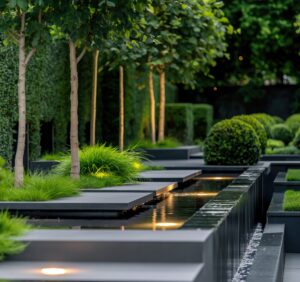A well-designed sprinkler system is the backbone of a healthy, vibrant landscape. At Browne & Associates, we have a good expertise in sprinkler system installation and repair, ensuring that your lawn and garden receive the precise amount of water they need to thrive. If you’re installing a new system or maintaining an existing one, our team combines technical expertise with a commitment to sustainability to deliver exceptional results.
This guide explores the key aspects of sprinkler systems, from installation to maintenance. It also highlights why professional services are essential for optimizing water usage while enhancing the beauty of your outdoor space.
Why Invest in a Professional Sprinkler System?
Ensuring Optimal Water Distribution
One of the primary benefits of a professionally installed sprinkler system is even water distribution. Proper irrigation is fundamental for maintaining the health of your plants, grass, and flowers. Without it, overwatering or underwatering can lead to issues like root rot, soil erosion, or dry patches.
Professional installers assess your landscape’s unique needs, considering factors such as soil type, plant species, sun exposure, and topography. This ensures that every area of your yard receives the appropriate amount of water. For example:
- shaded areas may require less frequent watering than sunny spots;
- flower beds often need more delicate irrigation compared to lawns;
- sloped terrains benefit from systems designed to prevent runoff.
By tailoring the system to your property’s specific requirements, professionals help you achieve a lush, healthy landscape with minimal waste.
Saving Time and Resources
Managing lawn care manually can be time-consuming and inefficient. A sprinkler system automates the process, freeing up your time while ensuring consistent watering schedules. Modern systems come equipped with smart controllers that adjust watering based on weather conditions, soil moisture levels, and seasonal changes. This not only conserves water but also reduces utility bills over time.
Additionally, professional installation minimizes the risk of costly mistakes such as improper pipe placement or inefficient sprinkler head positioning. By getting it right the first time, you save money on repairs and ensure long-term performance.
Enhancing Property Value
A well-maintained lawn significantly boosts curb appeal and property value. Potential buyers are often drawn to homes with automated sprinkler systems because they offer convenience and ensure a beautiful outdoor space year-round. If you’re planning to sell your home, investing in a sprinkler system is a smart choice. It enhances both aesthetics and functionality, allowing you to enjoy your home’s full potential.
Key Steps in Sprinkler System Installation
1. Comprehensive Site Evaluation
Before installing a sprinkler system, professionals conduct a thorough evaluation of your property. This includes:
- measuring the size and layout of your yard;
- identifying high-traffic areas that may require durable materials;
- assessing water pressure and flow rates to determine system capacity;
- mapping out zones based on plant types and watering needs.
This initial assessment ensures that the design is tailored to your landscape’s unique characteristics while maximizing efficiency.
2. Designing the System
Once the evaluation is complete, the next step involves creating a detailed design plan that includes:
- placement of sprinkler heads for optimal coverage;
- division into zones to accommodate different watering requirements;
- selection of materials such as PVC pipes or polyethylene tubing based on durability and cost-effectiveness.
The design also incorporates features like rain sensors, which prevent overwatering during rainy periods. Additionally, it includes drip irrigation systems for targeted watering in flower beds or vegetable gardens.
3. Installation Process
The installation process begins with trenching to lay pipes underground at appropriate depths (typically 6–12 inches). Pipes are then connected to valves that control water flow for each zone. Finally, sprinkler heads are installed at designated locations and adjusted for proper spray patterns.
Before completing the project, professionals flush the system to remove debris from pipes and test each zone to ensure everything operates smoothly.
Common Sprinkler System Issues (and How We Fix Them)
Leaks and Broken Pipes
Leaks can occur due to wear-and-tear or accidental damage during landscaping activities. Left unaddressed, they can lead to water waste and increased utility bills. Our team quickly identifies leaks using advanced diagnostic tools and repairs damaged pipes or fittings efficiently.
Clogged Nozzles
Dirt or debris can clog sprinkler nozzles over time, reducing water flow and causing uneven coverage. Regular maintenance involves cleaning or replacing clogged nozzles to restore optimal performance.
Malfunctioning Valves
Valves control water flow between zones but may fail due to electrical issues or mechanical wear. We inspect valve boxes during routine checkups and replace faulty components as needed.
Sustainable Practices in Sprinkler System Design
Water Conservation Features
Modern sprinkler systems prioritize sustainability by incorporating features like:
- Smart Controllers: Automatically adjust watering schedules based on weather data.
- Drip Irrigation: Delivers water directly to plant roots, minimizing evaporation.
- Rain Sensors: Pause irrigation during rainfall to prevent overwatering.
These technologies not only conserve water but also reduce environmental impact while keeping your landscape healthy.
Xeriscaping Integration
For homeowners looking to minimize water usage further, we offer xeriscaping solutions that combine drought-resistant plants with efficient irrigation systems. This approach reduces dependence on supplemental watering while maintaining aesthetic appeal.
Frequently Asked Questions (FAQ)
- How often should I have my sprinkler system inspected?
We recommend annual inspections before the start of the growing season to ensure optimal performance and address any issues early.
- Can I install a sprinkler system myself?
While DIY installation is possible for small projects, professional installation ensures proper design, placement, and long-term reliability—saving you time and money in the long run.
- What are smart irrigation systems?
Smart irrigation systems use advanced controllers that adjust watering schedules based on real-time weather data or soil moisture levels for maximum efficiency.
- How do I know if my system needs repairs ?
Signs include uneven coverage dry patches, increased utility bills and visible leaks around pipe fittings .
- Is winterization necessary for my sprinkler system?
Absolutely essential freezing temperatures cause pipes burst leading to costly repairs springtime.
- Do provide maintenance services post-installation ensure longevity projects are completed ?
Yes comprehensive plans tailored specific needs keeping pristine condition long-term enjoyment !
Investing in a professionally designed sprinkler system is one of the best ways to maintain a healthy landscape while conserving resources efficiently and effectively!
At Browne & Associates—we are committed to delivering tailored solutions to meet unique needs every client serves a trusted partner navigating complex modern irrigation confidently seamlessly! Contact us today to schedule consultation and learn more about transforming property durable efficient beautiful rooftop solutions tailored to your unique vision !



